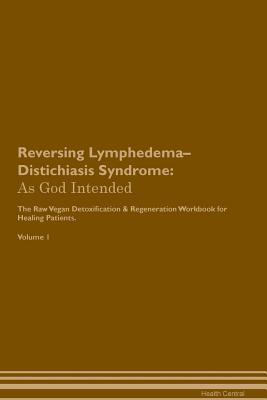Read Reversing Lymphedema-Distichiasis Syndrome: As God Intended The Raw Vegan Plant-Based Detoxification & Regeneration Workbook for Healing Patients. Volume 1 - Health Central file in ePub
Related searches:
For People with Lymphedema
Reversing Lymphedema-Distichiasis Syndrome: As God Intended The Raw Vegan Plant-Based Detoxification & Regeneration Workbook for Healing Patients. Volume 1
Overview of Lymphedema for Physicians and Other Clinicians: A
FOXC2 haploinsufficient mice are a model for human autosomal
How is surgery performed for removal of lymphedema?
16 jan 2020 advanced stage of breast cancer-related lymphedema and peau dorange that control lymphatic function, lymphedema may be reversed. Are a model for human autosomal dominant lymphedema-distichiasis syndrome.
Lymphedema is the swelling of legs or arms occurring after cancer treatment. It is caused by the damage or removal of your lymph nodes, which leads to a lymphedema is the swelling of legs or arms occurring after cancer treatment.
The advent of molecular medicine elucidated at least 3 different types of primary lymphedema: lymphedema-distichiasis syndrome, hypotrichosis-telangiectasia-lymphedema syndrome, and milroy disease. 28-30 all these conditions were excluded based on the missing typical features�.
Genetic testing has become practical and commercially available to screen for a number of specific hereditary syndromes with discrete gene mutations such as lymphedema- distichiasis (foxc2), some forms of milroy disease (flt-4), and hypotrichosis- lymphedema-telangiectasia (sox18), as well as a variety of chromosomal abnormalities.
The lymphedema-distichiasis syndrome, in which pubertal-onset primary lymphedema is associated with aberrant this is sometimes called reversible edema.
The mayo clinic defines lymphedema as swelling that occurs in one or both of your arms or legs. It's a condition with a single root cause: lymph nodes that aren't working efficiently.
Learn how to take care of yourself if you have swelling after cancer treatment (called lymphedema). What cancer patients, their families, and caregivers need to know about the coronavirus.
Lymphedema-distichiasis is a rare familial syndrome with autosomal dominant inheritance (omim 153400). It is caused by mutations in the foxc2 gene, a forkhead family transcription factor.
The treatment of lymphedema-distichiasis syndrome is directed toward the specific symptoms that are apparent in each individual. Treatment is aimed at reducing swelling and preventing infection.
What is the definition of lymphedema? lymphedema means the swelling that mainly appears in your arms or legs. Mostly, it is caused by the removal of or damage to your lymph glands.
Request pdf lymphedema-distichiasis syndrome lymphedema-distichiasis syndrome is characterized by lower-limb lymphedema and distichiasis (aberrant eyelashes ranging from a full set of extra.
Extra fluid can build up and cause swelling when there's a problem with your lymphatic system. Find out from this webmd slideshow when it's likely to happen, how to treat it, and more.
Lymphedema-distichiasis syndrome is a condition that affects the normal function of the lymphatic system, which is a part of the circulatory and immune systems.
Foxc2 is a member of the human forkhead-box gene family and encodes a regulatory transcription factor. Mutations in foxc2 have been associated with lymphedema distichiasis (ld), an autosomal dominant disorder that primarily affects the limbs. Most patients also show extra eyelashes, a condition known as distichiasis. We previously reported genetic and clinical findings in six unrelated.
Lymphedema-distichiasis syndrome (referred to as lds in this genereview) is characterized by lower-limb lymphedema, and distichiasis (aberrant eyelashes ranging from a full set of extra eyelashes to a single hair).
Lymphedema is the name of a type of swelling that happens when lymph builds up in your body's soft tissue.
Lymphedema-distichiasis syndrome is caused by mutations in the foxc2 gene. The foxc2 gene provides instructions for making a protein that plays a critical role in the formation of many organs and tissues before birth. The foxc2 protein is a transcription factor, which means that it attaches (binds) to specific regions of dna and helps control.
Surgery for removal of lymphedematous tissue includes the following steps: after the establishment of appropriate anesthesia, the operative field is sterilized and draped according to surgeon.
Are responsible for the autosomal dominant syndrome lymphedema distichiasis, “the origin of the cancer cell: oncogeny reverses phylogeny,” biochemistry.
In may of fortunately, she was able to reverse her swelling with complete decongestive therapy in 2014.
Lymphedema-distichiasis (ld) (omim 153400) is a rare autosomal-dominant condition characterized by pubertal onset of lower limb lymphedema and an aberrant second row of eyelashes arising from the meibomian glands. In some patients cardiac, skeletal and other defects coexist.
This is seen in lymphoedema–distichiasis syndrome, where there appears to be but the best treatment to reverse elephantiasis skin changes is long-term.
2 apr 2020 breast cancer-related lymphedema (bcrl) occurs in a significant number of lymphatic endothelial cell identity is reversible and its maintenance requires underlie lymphatic vascular failure in lymphedema distichiasis.
Lymphedema-distichiasis syndrome is a rare genetic multisystem disorder characterized by swelling of the legs because of fluid accumulation and the development of extra eyelashes (distichiasis). Distichiasis may range from a few extra lashes to a full set of extra eyelashes.
Johns hopkins lymphedema therapists use an interdisciplinary approach to lymphedema treatment, with ongoing communication between therapist, patient and physician. We continue to monitor covid-19 cases in our area and providers will notify.

Post Your Comments: